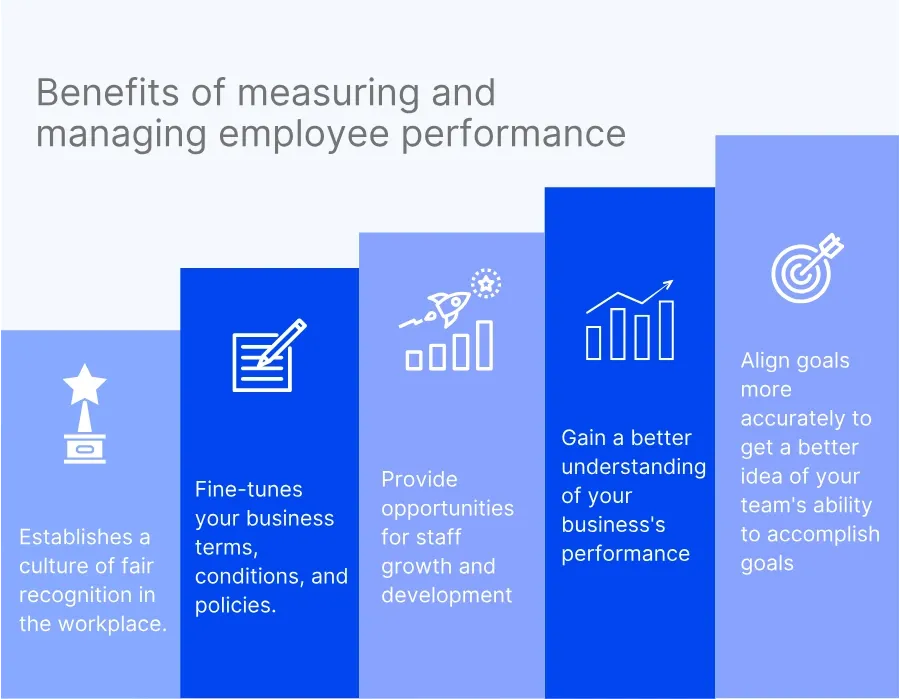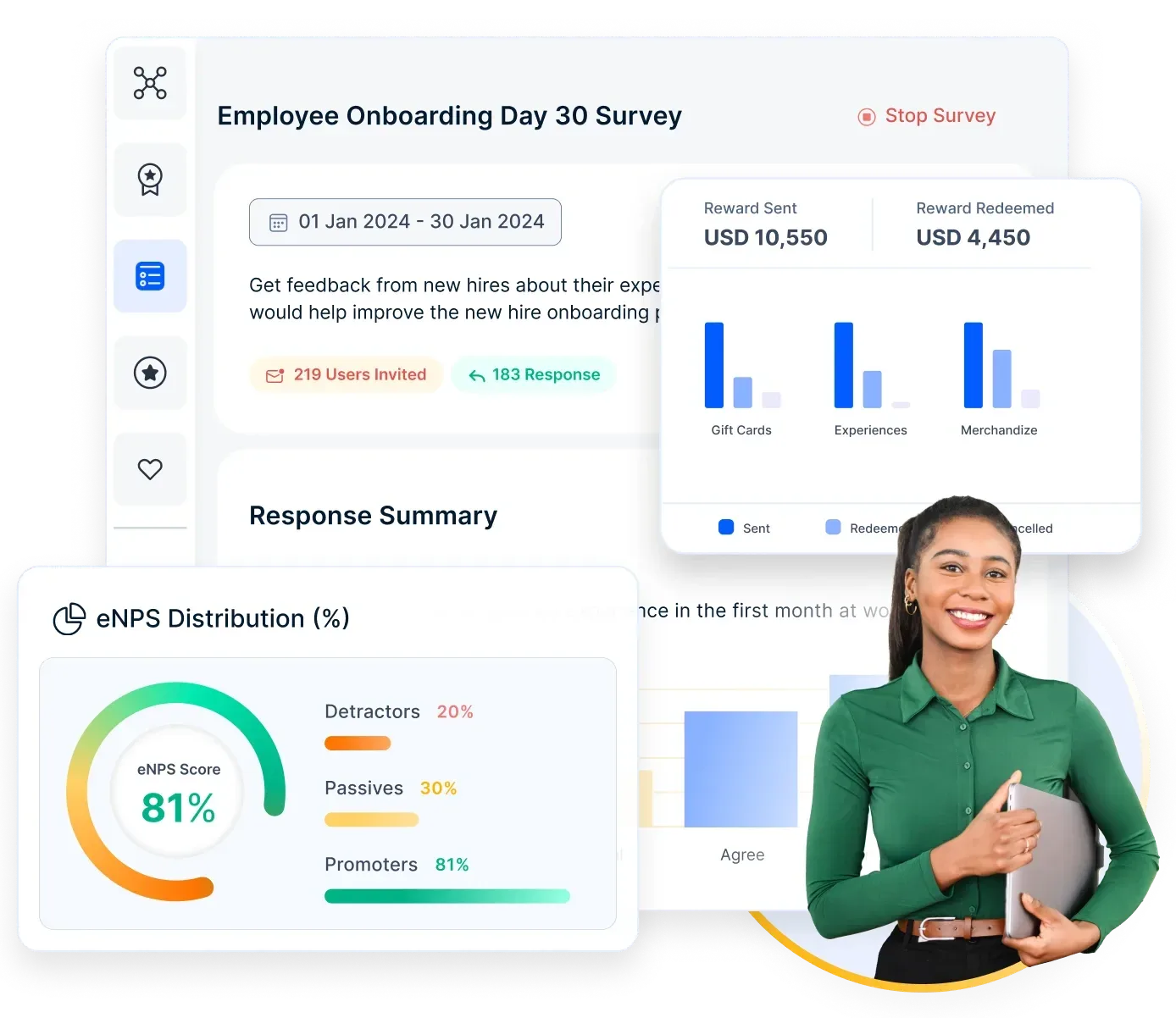Pengurusan Prestasi Pekerja: Faedah dan Petua untuk Meningkatkannya dengan Berkesan
Pengurusan prestasi pekerja bermakna memantau kerja pekerja secara berterusan untuk memahami sama ada ia sejajar dengan matlamat dan objektif organisasi. Terokai blog ini untuk mengetahui cara meningkatkan prestasi pekerja dengan berkesan.
Pada halaman ini
Employee performance management has evolved beyond annual appraisals into a continuous, data-driven approach. Managing employee performance today focuses on real-time feedback, goal alignment, and team collaboration rather than outdated individual assessments.
A McKinsey study highlights the shift from individual-centric performance management to a team-based model, reinforcing the need for organizations to rethink their strategies. Businesses adopting this approach see improved engagement, efficiency, and overall productivity.
To truly understand how to improve employee performance, exploring its benefits, practical implementation strategies, and direct impact on business success is essential.
Let’s get started.
Apakah pengurusan prestasi pekerja?
Employee performance management is not just about measuring and improving the performance of the employees. It is also about aligning individual objectives with the organization's and vice versa.
The performance management process is continuous rather than an annual review. The goal of performance management focuses on building your employees' ability to perform their work better. Skills improvement and professional development are both essential parts of performance management.
Walau bagaimanapun, pengurusan prestasi juga merupakan jalan dua hala. Anda perlu mengukur sama ada pekerja sesuai untuk pekerjaan mereka dan sama ada pekerjaan itu menggunakan set kemahiran pekerja sepenuhnya. Dalam erti kata lain, ia melibatkan menyelaraskan tugasan kerja dan kemahiran seseorang dengan matlamat pasukan dan organisasi pekerja.
Benefits of employee performance management

Pakar pengurusan Peter Drucker pernah terkenal berkata, "Apa yang diukur dapat diuruskan." Dalam era di mana majikan melihat prestasi sebagai lebih daripada pendapatan yang dibawa oleh pekerja mereka ke dalam syarikat, pepatah ini masih relevan.
Anda tidak boleh menguruskan sesuatu yang anda tidak tahu. Mengukur prestasi pekerja adalah langkah pertama dalam mengurus dan akhirnya memperbaikinya.
Why should your company measure employee performance in the first place? One recent study published by Capgemini argues that employee performance, including productivity and engagement, is closely linked to the employee experience. In other words, high-performing employees and teams work in a high-performance workplace and vice-versa.
Melaksanakan sistem pengurusan prestasi pekerja akan memberi manfaat kepada organisasi anda dengan cara berikut:
1. Memberi peluang kepada pertumbuhan dan pembangunan kakitangan
Sebagai pengurus, anda boleh mempengaruhi prestasi organisasi anda dengan memberi perhatian kepada prestasi orang yang bekerja dengan anda.
However, you must implement an employee performance management system to record and compare your observations to specific growth and development targets. Otherwise, you'll just be making uninformed guesses.
By using an employee performance management system, you'll have all the data you need to identify improvement opportunities and predict your employees' career trajectory.
For example, suppose an employee does poorly in numerical tasks but has excellent communication skills. In that case, you can either train them in numbers or steer them towards a career path that can maximize their strengths.
2. Selaraskan matlamat dengan lebih tepat
Before setting your goals, you must assess your team's skills, availability, and performance. By measuring and managing employee performance, you better understand your team's ability to accomplish goals. As a result, you can either adjust your goals to account for your team's strengths and weaknesses or hire additional resources to help you reach your targets.
The first step in employee management is recruiting or assigning the right person for the job. It is, therefore, essential to have a holistic approach leveraging business acumen for an effective role assignment process.
Once that is done, you should set performance goals with your new employee with the organization's larger goals in mind. This might not seem easy if the employee works remotely. Still, with constant check-ins and alignment sessions, they will understand how you will monitor their performance for the remainder of the assessment period.
3. Dapatkan pemahaman yang lebih baik mengenai prestasi perniagaan anda
Orang membuat organisasi, dan ia adalah prestasi kolektif mereka yang memacu pertumbuhan. Oleh itu, mudah difahami mengapa anda perlu mengukur prestasi individu untuk memahami prestasi organisasi dengan lebih baik.
Ini terutama berlaku untuk perniagaan kecil, di mana output beberapa pekerja dapat mengeja perbezaan antara mengubah keuntungan atau beroperasi pada defisit. Melakukan penilaian pekerja boleh membantu anda mengenal pasti prestasi terbaik dan mereka yang memerlukan penambahbaikan.
Ia juga boleh membantu anda mengenal pasti kedua-dua jurang pengetahuan yang menyebabkan perniagaan anda berprestasi di bawah jangkaan dan keupayaan pekerja yang boleh anda gunakan pada masa akan datang.
4. Perhalusi dasar perniagaan anda
To build a company culture that attracts and retains great employees, you must combine your employee performance appraisal data with the employee experience. You can collect this at different touchpoints in the employee lifecycle. These points include periodic employee satisfaction surveys and exit interviews.
Apabila anda menganalisis data pengalaman pekerja dalam konteks prestasi pekerja, anda boleh mempunyai pandangan yang lebih jelas tentang kesan satu sama lain.
For instance, if an employee says they wish they could have worked remotely more often in their exit interview, you can determine the lack of remote working options and suboptimal performance.
You can also make your analysis as granular as possible to identify previously unknown factors that affect employee performance. For example, a study published by the University of Oxford discovered that more windows (and natural light) in the workplace had a positive effect on sales and efficiency.
Anda kemudian boleh menggunakan wawasan ini untuk mewujudkan budaya tempat kerja yang menggalakkan pekerja untuk berprestasi lebih baik sambil mengekalkan keseimbangan kerja-kehidupan yang sihat.
5. Mewujudkan budaya pengiktirafan adil
Using employee performance reviews, you can establish a culture of fair recognition in your organization. On the one hand, by identifying top performers and rewarding them, you show your workforce that you appreciate and recognize hard work. It is crucial to do this, as employee recognition is the number one factor driving employee engagement and productivity.
Sebaliknya, seorang pekerja yang kurang dalam prestasinya memerlukan pengurusan yang lebih dekat. Mengenal pasti pelaku lemah tepat pada masanya adalah penting supaya anda boleh membuat rancangan pembangunan untuk meningkatkan kemahiran mereka dan mengurangkan kesilapan.
Jika itu tidak berfungsi, anda perlu memutuskan dan menyampaikan akibat kepada tenaga kerja untuk mendapatkan tindakan mereka bersama dengan sewajarnya. Kehilangan salah satu daripada ini boleh memberi kesan yang teruk kepada perniagaan anda.
How do you manage and improve employee performance effectively?
Good performance management entails more than just building a productive workplace. Understanding how to improve employee performance requires leadership, strong social skills, the ability to give constructive feedback, and teamwork—all essential for an effective performance management strategy.
1. Tetapkan matlamat dan objektif yang jelas
Tanpa matlamat yang jelas, anda dan pasukan anda tidak akan mempunyai idea tentang kemajuan anda dan berapa banyak alasan yang perlu anda tutup. Kebanyakan pakar pengurusan percaya kepada beberapa prinsip asas penetapan matlamat:
Prinsip-prinsip ini memberikan pemimpin idea yang baik tentang matlamat yang perlu mereka tetapkan untuk diri mereka sendiri dan pasukan mereka.
Anda juga boleh menggunakan kriteria SMART semasa memutuskan matlamat pasukan:
- Specific: What are you looking to accomplish, and what are the steps to it?
- Measurable: What are the key performance indicators of the goal?
- Achievable: Is this goal based upon realistic metrics? Is the employee equipped enough to achieve it?
- Relevant: Does it fit well in the employee's overall work profile and company priorities?
- Time-based: What are the deadlines for each goal?
Berikut adalah contoh papan matlamat SMART dari Hubspot -
Penetapan matlamat adalah penting untuk menguruskan prestasi pekerja dalam mana-mana pasukan tetapi lebih penting lagi untuk pasukan jarak jauh. Pasukan jarak jauh mungkin merasa hilang sepenuhnya jika mereka tidak diberi arah yang jelas dari segi matlamat dan objektif syarikat, kerana mereka tidak berkomunikasi dengan pasukan teras mereka setiap hari.
The goals you set for your employees will depend on their line of work. For example, if you employ graphic designers, you can gauge their work's quality and adherence to branding guidelines. If you manage a data analysis team, you can use data quality metrics as your basis for performance management.
2. Gunakan perisian untuk pengurusan prestasi
You need a way to track progress efficiently, and ideally, the information you are gathering should be accessible to everyone. Using Google Sheets or Microsoft Excel is not uncommon for employee management, but dedicated performance management software will make things easier and more streamlined for you.
Real-time management: Some tools may offer the capability to monitor your team's performance in real-time, often through features like time tracking or integration with time tracking apps. It allows you to gain immediate insights into your team's productivity, project status, and individual contributions.
Berikut adalah beberapa faktor yang perlu dipertimbangkan semasa memilih perisian pengurusan prestasi pekerja:
💸 Cost: Enterprise-level software, such as SuccessFactors or Workday, might be out of your budget. You can use performance management software targeted towards small businesses instead.
🔗 Features and integrations: Most employee performance management software have some level of integration with other HR-related systems, including payroll and employee recognition solutions. These integrations will streamline the experience for your employees and the HR team.
🔧 Ease of use and training: Performance management software has many moving parts, and getting lost in all the features is quite easy. Aim for simplicity when you're looking for a system for your team.
Kebanyakan perisian untuk pengurusan prestasi pekerja mempunyai pendekatan yang fleksibel dan boleh membina papan pemuka mengikut keperluan khusus anda. Anda boleh mencuba demo untuk memilih produk yang betul.
3. Memberi maklum balas prestasi yang kerap
Providing relevant and regular feedback 📝 is an essential element of performance management. It can take many forms:
- Managers give feedback to employees as part of a performance review.
- Pekerja memberikan maklum balas kepada pengurus mereka.
- Melaksanakan maklum balas rakan ke rakan.
Anda mungkin tertanya-tanya berapa kerap anda perlu memberikan maklum balas.
Walau bagaimanapun, jenis maklum balas yang dianggap bermakna tidak sesuai dengan kategori yang terdapat dalam sesi penilaian berkala biasa. Sebaliknya, perbincangan harus memberi tumpuan kepada pengiktirafan, hala tuju kerjaya, dan emosi pekerja, terutamanya pada masa ketidakpastian seperti pandemik global.
Also, how you give feedback can change the results to a large extent. For example:
- Daripada mengatakan sesuatu tidak berfungsi, jelaskan mengapa dan letakkannya dalam konteks perniagaan yang lebih besar.
- Daripada mengatakan "pekerjaan yang baik", katakan apa yang berjaya.
- Daripada memikirkan apa yang salah, jemput pekerja untuk membincangkan apa yang boleh mereka lakukan dengan lebih baik pada masa akan datang.
Instead of talking like a boss, talk like a team member and avoid adverse and judgmental phrasing. Good performance management software comes in handy in managing feedback effectively.
4. Provide them with adequate work equipment
Providing the right resources boosts workplace efficiency and overall performance. Adequate work conditions also play a crucial role—office setup influences behavior, productivity, and morale.
Lack of proper equipment affects performance and compromises safety. Cutting corners on essential tools can lower morale and increase turnover. In physically demanding roles, quality equipment reduces injury risks, reinforcing ethical employer practices.
Some tools enhance efficiency, while others minimize time spent on repetitive tasks. Proper hardware and licensed software are essentials. For teams needing seamless communication, reliable tools improve workflow—meanwhile, employees handling written content benefit from supportive service providers.
5. Identify emotional vampires
Some people simply draw the life force from everyone in their vicinity. They’re not directly impacting productivity by underperforming or sabotaging the rest of your team, but they might undermine the office’s morale daily. It is necessary to provide a healthy work environment.
Kajian juga menunjukkan bahawa individu-individu ini mempunyai kesan yang lebih mendalam terhadap rakan sekerja mereka daripada yang diandaikan sebelumnya.
The problem in spotting these individuals may lay in two things.
- Pekerja anda mungkin enggan menutup mulut rakan sekerja mereka (walaupun mereka tidak suka bekerja dengan mereka).
- They aren’t necessarily underperforming or performing poorly in your employ.
Oleh itu, pastikan anda membangunkan sistem maklum balas yang cekap dan mempunyai tahap kepercayaan dengan pekerja anda begitu tinggi sehingga mereka akan berasa selesa memberitahu anda perkara-perkara ini.
Sebaik sahaja anda mengenal pasti vampire emosi, anda boleh melakukan dua perkara.
- Memecat mereka untuk tidak menjejaskan produktiviti seluruh kakitangan anda.
- Tawarkan mereka peluang untuk bekerja dari rumah atau meletakkan mereka dalam kedudukan di mana mereka mempunyai sedikit interaksi dengan seluruh pasukan anda yang mungkin.
The first option is much more reliable because an emotional vampire can still substantially damage office morale, even in the virtual environment.
6. Show your team that you care about them
Many entrepreneurs assume the customer-is-always-right principle applies universally, but that’s not always true. If a customer is rude or unreasonable, they may not be worth the effort to retain. Trying too hard to keep them can drain resources and demoralize your team—a concept known as customer bullying. Prioritizing toxic customers over employees can hurt productivity and morale.
One of the best ways to show employees they matter is by making time for them. While your team is small, regular one-on-one meetings can be invaluable. These sessions help you align on priorities, address concerns, and reinforce that their contributions are valued.
Author Elizabeth Grace Saunders highlights that personal attention from leadership fosters loyalty and engagement like nothing else. Simple actions—asking about project progress, remembering personal details, or supporting team collaboration—go a long way. Leadership is more than managing tasks; it’s about building relationships that drive success.
7. An adequate reward for an adequate effort
It is only natural that people are more interested in what they can do for them than what they can do for you, which is why you need to start considering the intrinsic motives of your team.
First, people care about their finances, which is why the promise of a raise is compelling. Second, those who are more career-oriented may focus on the ability to rise in the ranks, which is why some room for vertical movement may also work.
Walaupun dua yang disenaraikan di atas mungkin bagus untuk motivasi jangka pendek seseorang, motivasi jangka pendek kakitangan anda dalam projek juga mungkin merupakan perkara yang patut dipertimbangkan. Inilah bonus yang ada.
Ini amat berkesan apabila pasukan anda baru sahaja menyiapkan projek utama, dan anda menjangkakan mereka akan memulakan projek lain seperti yang telah dilakukan. Dengan memberikan bonus kepada mereka, anda akan mengingatkan mereka mengapa mereka bekerja lebih keras untuk memberikan hasil kepada anda. Sebaliknya, beberapa kajian mendakwa sebaliknya.
8. Invest in employee development
More competent employees equal a more productive workforce. To ensure your team is always ready to tackle any challenge and keep up with the innovations in the industry, investing in employee learning and development is the best course of action.
Walaupun ini kelihatan seperti penyelesaian yang mahal untuk beberapa pemilik perniagaan, ini adalah amalan yang pasti akan membantu syarikat anda bergerak ke hadapan.
Courses, seminars, workshops, and mentoring programs will help your employees grow professionally, making them more skilled, efficient, and productive in the workplace.
9. Motivate using incentives
Incentives are a great way to reward the most productive employees for well-done jobs, and they show the whole team you value their hard work and contributions.
Incentives can include various benefits, from paid time off, bonuses, and raises to organizing team-building activities where your staff can relax and get to know each other better.
10. Organize regular performance reviews
Penjadualan penilaian pekerja tetap memberikan peluang berharga kepada pihak pengurusan untuk memberikan maklum balas individu untuk setiap ahli pasukan.
However, these meetings are also helpful in finding out what troubles your employees, what they might miss in the workplace, and what would make them more motivated and driven to fully commit to their everyday tasks
11. Stay in the loop and communicate openly with your team
Boosting employee engagement and performance is a process that requires long-term dedication and attentiveness.
To make sure your employees understand their assignments and do their best to accomplish them in the most effective and timely manner, stay in the loop and openly communicate with your team.
12. Pembinaan pasukan dan komuniti
Perkara lain yang perlu anda ingat ialah kesetiaan adalah motivator yang berkesan, walaupun bukan hanya anda yang setia kepada ahli pasukan anda.
Remember that working on a project with people they hold in high esteem might place your employees in a position where they feel the pressure to work extra hard not to let their team members down.
In this particular case, validation of their peers means more than any kind of positive feedback on your side. This is a benefit of being in a harmonious and well-composed team.
Mencapai matlamat ini, sebaliknya, memerlukan banyak usaha di pihak anda.
- Ia memerlukan anda untuk menyediakan pasukan anda dengan beberapa aktiviti dan peluang pembinaan pasukan.
- It requires you to allow your staff to mingle outside of work. We’re talking about field trips, corporate parties, and other opportunities for them to get to know each other in a bit more relaxed environment.
- Yang paling penting, anda perlu menjadikan pejabat anda persekitaran di mana membuat kawan mudah dan mungkin.
Sentiasa berada di bawah tekanan dan perasaan dipantau / diawasi akan membunuh getaran ini di sekitar pejabat. Pastikan ahli pasukan anda berasa menyenangkan di pejabat, dan perpaduan pasukan akan melonjak dalam masa yang singkat.
Perkara terakhir yang perlu anda fokuskan ialah memberi ganjaran kerja berpasukan dan bukannya usaha individu. Backstabbing dan melemahkan rakan sekerja kerana persaingan hanya akan berlaku jika anda membuat persekitaran di mana amalan ini memberikan hasil.
Angka-angka di sini agak mengejutkan, melihat bagaimana 29% mengatakan bahawa ada seseorang di tempat kerja mereka yang menjadikan kehidupan mereka neraka hidup, dan 14% mendakwa lebih daripada satu orang membuat hidup mereka sengsara.
Untuk memburukkan lagi keadaan, ini memulakan kitaran ganas, melihat bagaimana kira-kira 31% subjek ujian berminat untuk membalas dendam terhadap seseorang yang membahayakan mereka, sehingga meningkatkan lagi perkara tersebut.
You'll create a team-friendly environment by rewarding teamwork instead of praising only the staff members who are constantly there for others.
Remember that you can expect your employees to continuously act like this if you endorse backstabbing behavior in your office. In other words, you can’t expect to reward such behavior and then act surprised once it takes over your office.
How to improve employee performance with Empuls

Good performance management entails more than just building a productive workplace. Establishing an effective employee performance management strategy requires leadership, strong social skills, the ability to give constructive feedback, and teamwork. Empuls enhances this process by providing tools that foster meaningful reviews and continuous improvement.
✔ Gather comprehensive feedback: Use Empuls' 360° feedback surveys to collect insights from managers, peers, and subordinates, ensuring well-rounded performance evaluations.
✔ Leverage data-driven insights: Empuls' HR People Analytics offers real-time performance data, helping leaders make informed decisions and drive employee growth.
✔ Monitor engagement levels: Keep a pulse on employee sentiment with real-time surveys, allowing proactive support to maintain high performance and morale.
A structured, insightful review process improves employee performance and fosters long-term success. Empuls helps organizations build a culture of feedback, growth, and continuous development.
Tutup
It is clear now that the benefits of measuring and managing employee performance take care of more things than one can imagine. The entire work environment is uplifted from employee development, improved relationships between managers and employees, synergy between teams, hitting targets, and beyond.
So, if you are wondering how to manage employee performance effectively, you can now start building a robust process and make it as continuous as it is supposed to be.








